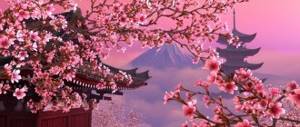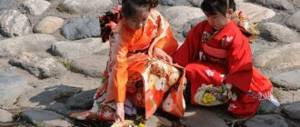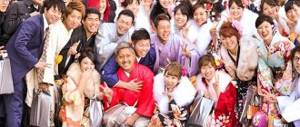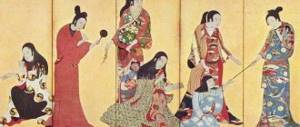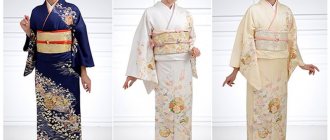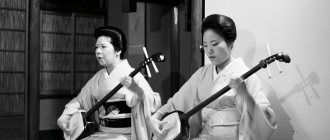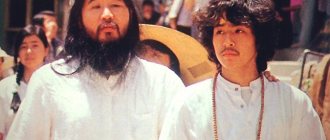In this article you will find Japanese national holidays and some of the most important annual national events. In addition, annual festivals are also listed here.
Like us, if a national holiday falls on a Sunday, the following Monday is also considered a holiday. Likewise, a day that falls between two national holidays becomes a holiday.
Shops, restaurants and tourist attractions in Japan are generally open on national holidays other than New Year's.
New Year
Ganjitsu 元日, "New Year", begins with Shogatsu 正月, which usually falls on the first three days of the year. This is one of the most important public holidays in Japan.
During this time, the Japanese eat a special dish, O-sechi ryori (お節料理), consisting of pickled, sweet and dried foods that can be stored without refrigeration. This tradition dates back to the days when homes did not have refrigerators and stores were closed for holidays.
Most Japanese people visit the temple on New Year's Day to pray, especially after getting up early to see the first sunrise of the year . Sometimes people climb mountains for hours at night to reach the top and prepare for sunrise.
There is also the Japanese custom of writing New Year's cards (年賀状, nengajō) by hand to each close family and friend, wishing them a Happy New Year and letting them know that everyone is happy and healthy (and alive). Children also receive a New Year's gift (お年玉, Otoshidama), money in envelopes from their parents or grandparents.
Read more about how the Japanese celebrate the New Year in our article.
Tanabata
The Tanabata Festival (“Seven Evenings”) has a history of more than a thousand years. The celebration begins on the seventh of July. The country is decorated with bamboo branches prepared especially for the celebration.
According to legend, the king of heaven, Tenko, had a daughter, Orihime. She spun clothes of extraordinary beauty. Her products were so beautiful that the father forced his daughter to work every day. But due to constant work, the girl could not meet and fall in love with anyone. Tenko, wanting to make his daughter happier, introduced her to the shepherd Hikoboshi.
The young people fell in love at first sight and soon got married. They spent a lot of time on each other, and so soon the cows scattered along the banks of the Heavenly River, and Orihime stopped spinning.
Tenko got angry and decided to punish them. He separated them on opposite sides of the sky. But Orihime begged her father to have mercy and let her see her husband. Once a year, on the seventh day of the seventh month, when Altair and Vega intersect, Orihime and Hikoboshi can see each other.
Coming of Age Day
Seijin no hi (成人の日, “Coming of Age Day”) falls on the second Monday of January . On this holiday, congratulations are given to those who have reached the age of 20 - the age of majority in Japan.
In local city halls in all prefectures, young people gather to participate in a coming-of-age ceremony: women wear a long-sleeved kimono (振袖, furisode) and men wear a hakama (袴, traditional long wide pleated pants), although nowadays men usually wear Western-style suits. After the official part ends, friends gather in groups and have fun in the city.
Setsubun
The third of February begins with a multi-voiced cry: “They are wa-a-a soto! Fuku wa-a-a-uti!”, which calls on evil spirits to leave the house and calls for happiness.
Ancient Japanese holidays have an interesting history, and Setsubun is no exception. Buddhism is the belief that every object and thing has a spiritual embodiment. Likewise, in Setsubun, the exorcism of evil spirits, or Mame-maki, is carried out in all houses.
In addition to apartments and houses, evil spirits are also expelled from churches. This event attracts many spectators. At the end of the ritual, people dressed as devils run out of the temple, symbolizing purification.
Day of spring equinox
Typically celebrated sometime between March 19-22, according to astronomical measurements, Shunbun no hi (春分の日, "Day of the Vernal Equinox") was a holiday associated with Shintoism . Now it is the holiday of the spring equinox , when the number of hours of day and night becomes equal. This day is considered the official change of seasons, just as Shubun no hi (秋分の日, "Day of the Autumnal Equinox") signifies the arrival of autumn.
During the spring equinox, people usually visit the graves of loved ones , paying tribute to their ancestors, and do spring cleaning, which signifies renewal.
People take a day off to spend time with their families and enjoy the arrival of spring after a cold winter.
Obon
From the thirteenth to the fifteenth of August, a holiday is held throughout Japan during which the memory of the dead is honored. The three-day Lantern Festival obliges Japanese people to visit the graves of deceased family members.
When darkness falls, people release paper lanterns to symbolize the souls of the dead. According to Buddhism, lanterns will help souls find their way home.
Although Obon is not an official holiday, almost all offices and companies close for this period. Every Japanese tries to visit their home and remember the memory of departed family members.
Showa Day
Showa no hi (昭和の日, "Showa Day"), held on April 29 , was originally a holiday in honor of the birthday of the Showa Emperor Hirohito (1926-1989). The meaning of this holiday is to reflect the turbulent years of the Showa era - the time when the Japanese invaded foreign countries, tried to stage a coup d'etat, the time of totalitarianism, World War II and the Japanese post-war economic “miracle”.
It also kicks off Golden Week (ゴールデンウイーク), the busiest time of year for travel in Japan.
This week is the “mother” of all Japanese public holidays. Showa Day, Japanese Constitution Day, Greenery Day and Children's Day line up the holiday week for busy Japanese employees, and some companies even close completely during this time.
Japan Holidays
Dear readers! Introducing Japanese holidays! No one doubts that Japan is an Asian country. Its history has survived more than two thousand years of imperial rule (from the 6th century BC)…
In many Japanese holidays that have survived to this day, temples and shrines play a major role, for example, in Naked Men's Day and in the New Year. Some of them are associated with beautiful legends. This is in the Tanabata holiday, the Moon Watching Festival. Some festivals are simply delightful, such as Girls' Day, while others are shocking, for example, the Festival of Iron Phalluses. It is pleasantly surprising that the Japanese know how to enjoy small annual miracles, such as the “sakura blossom” or the “full September moon”.
The situation changed after the middle of the last century. Those who are familiar with history are well aware that after the defeat of militaristic Japan in World War II, the country was under American occupation (from 1945 to 1952). And the United States was responsible for the post-war structure of Japan. In 1947, a new Japanese constitution was adopted.
The rule of the imperial dynasty was replaced by parliamentary democracy. From that moment on, Japan began to position itself as a secular state. Many holiday names have changed, and new holidays have also appeared, such as Labor Thanksgiving, Valentine's Day, White Day, Mother's Day... Despite the fact that now the imperial dynasty rules the country only “in name”, Japan maintains respect for its history and to the imperial family. The country annually holds relevant holidays, such as Shewa Day (Showa), the Emperor's Birthday.
Major holidays in Japan in 2021:
New Year (January 1), Coming of Age Day (January 13), State Foundation Day (February 11), Valentine's Day (February 14), Emperor's Birthday (February 23, 24), Girls' Day or Doll Festival (March 3), Showa Day (April 29), Constitution Remembrance Day (May 3), Greenery Day (May 4), Children's Day (May 5), Mother's Day (2nd Sunday in May), Sea Day (July 23), Sports Day ( July 24), Hiroshima Memorial Day (August 6), Nagasaki Memorial Day (August 9), Mountain Day (August 10), Senior Citizens Day (September 21), Culture Day (November 3), Labor Thanksgiving Day (November 23), Christmas (December 25).
However, it's time to travel to some of Japan's holidays...
1. New Year (January 1)
New Year's Eve is called Omisoka here. This day is one of the main holidays of the year. And it should be spent with your closest relatives. People usually go out for dinner at a restaurant or prepare a special New Year's meal at home. During the New Year's feast, they drink sake rice vodka, have a pleasant conversation, reflect on the past year, and dream about the future. At midnight in Japan it is customary to offer prayers to God. On New Year's Eve, crowds gather at local temples to hear the traditional Joya no Kein. At midnight, it is considered very auspicious to listen to the chime of the temple bell. According to Japanese religion, the sound of 108 chimes “drives away all sins” and “gives birth to new life.”
Read the article: “How is New Year celebrated in Japan? "
2. National holidays of Japan:
State Foundation Day (February 11) Showa Day (April 29) Constitution Day (May 3)
For many years, April 29 was celebrated in Japan as the birthday of Hirohito, who was emperor from 1926 to 1989. After his death the holiday was cancelled. Instead, Greenery Day began to be celebrated on this day. Since 2005, this Green Day holiday has been moved to May 4th. And April 29 became Showa Day (JapanShōwa). Showa is the posthumous name of Emperor Hirohito. The period of his reign was called Shōwa, which can be roughly translated as "shining Japan". By the end of Emperor Hirohito's reign, Japan had the second largest economy in the world after the United States. The purpose of this holiday is to think about the future of the country and not forget about the Shōwa period.
Read the article: “National holidays in Japan”
3. Valentine's Day (February 14)
In the Land of the Rising Sun, Valentine's Day (Valentine's Day) is celebrated in a very unique style. Here ladies present gifts to their boyfriends, as well as male friends and relatives.
Read the article: “Valentine's Day and White Day in Japan”
4. Naked men's race (Hadaka Matsuri) (3rd Saturday of February)
The Naked Man Festival takes place on the third Saturday of February. It was once held in all the cities and villages of this island state. At the moment, the festival is celebrated only in some cities. This is Inazawa city, Kyoto city, Okayama city. The festival is attended by men aged 23 to 43 years. Women, old people and children are prohibited from participating. The modern holiday does not contain elements of violence against a “naked person.” However, this action cannot be called an easy adventure in a loincloth. There are features of holding in different cities.
Read the article: “Festival of Naked Men”
5. Girls' Day in Japan (Hinamatsuri) (March 3)
On March 3, girls in Japan celebrate Girls' Day. A few days before the start of the holiday, a special stepped stand (khinadana) is installed in every house where families with girls live. Dolls representing the imperial family of the Heian era are seated on this stepped structure. At the very top are dolls of the emperor and empress. On the lower step are dolls of three court ladies. Even lower are ministers, musicians, servants. This composition is completed by palace interior items: doll chairs, sofas, tables. Miniature cats and dogs are also here. You can also see miniature dishes. The exhibition is complemented by decorative peach and plum trees.
Read the article: “Girls' Day in Japan”
6. White Day (March 14)
What's even more unique about Japan is that they now have White Day, which takes place on March 14th. On this day, the entire male population of Japan must present gifts to the representatives of the weaker half of humanity, who gave them chocolate on Valentine's Day. When March 14th comes, Japanese men of all ages are expected to give return gifts worth at least three times the value of the gifts received.
Read the article: “Valentine’s Day and White Day in Japan”
7. Admiring cherry blossoms (O-hanami) (2nd half of March)
Since 1992, the Japanese have had a cherry blossom holiday. The holiday symbolized the arrival of spring. Since then, it begins approximately in the second half of March according to the Gregorian calendar and lasts two weeks. Flowers last on the tree for about 5 days. But since the beginning of flowering in different varieties occurs at different times, the holiday continues until the end of March. The appearance of the first flower is watched by servants of a Buddhist temple in Tokyo. They announce the beginning of cherry blossoms.
Read the article: “Cherry blossom festival in Japan”
8. Iron Phallus Festival (Kanamara Matsuri) (1st Sunday in April)
Currently, the tradition of honoring the phallus has been preserved and turned into a real holiday. It is called the Phallus Festival or Kanamara Matsuri. Some call it the Penis Festival or the Iron Phallus Festival. The center of the holiday is Katoyama Shrine in the city of Kawasaki. This structure is built in the shape of a phallus. It contains three huge penises. The holiday begins on the first Sunday in April and lasts for a whole week. The central event of the holiday is a procession to the beat of drums. Male organs of all sizes and colors are the main characters in this fun festival. A huge pink penis is carried by transvestites. Here you can also see black and flesh-colored male organs. People try to touch these symbols of masculinity. They believe that this will bring them family happiness.
Read the article: “Penis Festival in Japan”
9. Mother's Day (2nd Sunday in May)
In Japan, Mother's Day is also celebrated in May (second Sunday). The first celebration took place in 1931 on the birthday of Empress Kojun. But in 1949 it was decided that the holiday should coincide with Mother's Day in America (2nd Sunday in May).
Read the article: “Mother’s Day is celebrated around the world”
10. Festival of Love (Tanabata) (beginning of August)
The Tanabata Festival is one of the favorite holidays in Japan. It is held in all corners of this island state. Each prefecture, each city brings its own bright colors to the universal holiday of love! City streets and shopping centers are dressed up in traditional Japanese decorations with ribbons. Bamboo branches are installed everywhere, onto which long multi-colored paper strips are attached. They are called tanzaku. The Japanese write their wishes in verse on them. Young unmarried Japanese women ask to send them a meeting with their only love in life.
Read the article: “Tanabata in Japan”
11. Moon watching festival (mid-September)
Currently, the holiday of admiring the moon, of course, has somewhat changed its interpretation. The modern Tsukimi holiday is not only about “admiring the moon”. It is a day of expressing gratitude and appreciation to nature for its gifts. Therefore, the moon at this time is also called the “Harvest Moon.” It is also no coincidence that Tsukimi is called the Mid-Autumn Festival or the Autumn Harvest Festival. Japanese people celebrate Tsukimi with their families by watching the moon and enjoying the sweets Mochi or Tsukimi dango. There are more than 10 types of Mochi. But the ones eaten on Tsukimi night must be special! Other popular products at Tsukimi are chestnuts, pumpkin, beans, and sake.
Read the article: “Moon Watching Festival in Japan”
12. Labor Thanksgiving Day (November 23)
On Labor Thanksgiving Day, people organize numerous events in all corners of the country. The most popular is the labor festival in Nagano. The event focuses on issues of human rights, peace and the environment. Most events are sponsored and hosted by local labor organizations. On this day, children, especially primary school students, engage in painting or arts and crafts. They give them as gifts to local police stations.
Read the article: “Labor Thanksgiving Day in Japan”
This is how Japanese holidays are celebrated!
Read about holidays and festivals in different countries of the world here:
Read the article: “Holidays and festivals around the world”
Popular festivals around the world
Read about the main national (public) holidays of other countries here:
Main national holidays of different countries
Dear readers! Write comments! Read articles on the World of Holidays website!
Sea Day
Sea Day (海の日, umi no hi) is held on the third Monday of July . It is a celebration of the ocean and its bounty. For the island nation, the ocean has always been and will always be a very important part of Japanese culture. The holiday usually also marks the end of the rainy season, giving people even more reasons to enjoy the summer and the sun by spending time at the beach.
"Golden Week" and "Silver Week"
April 29 and four consecutive weekends in early May are called “Golden Week.” This is the time for tourist trips and family vacations; It is better to book tickets and hotels for this time in advance.
Many holidays are tied to Mondays, although some are celebrated on specific days of the year. If such days fall on Sunday, then the day off is transferred to Monday, but if Saturday becomes a holiday, there is no additional day off.
In 2015, since September 21 and 23 are holidays, an additional day off will be September 22. This holiday only occurs when there is a regular working day between two weekends, and was first introduced in 2009. This weekend is called “Silver Week” and in 2015 it will happen for the second time.
Physical Education Day
Taiiku no Hi (体育の日, "Physical Education Day") is held on the second Monday of October to commemorate the 1964 Summer Olympics in Tokyo. The government encourages sports and an active lifestyle.
Japanese schools celebrate this day with Undokai (運動会), a huge event for each school in which students participate in physical activities ranging from athletics to tug of war and local regional games. Teachers challenge students to relay races, parents join in fun races with their kids, and the whole day turns into an outdoor festival!
October
Sake Day (1st)
The Japanese are very fond of cheerful feasts, which are accompanied by drinking sake. Japanese vodka is literally considered one of the state's national treasures.
Almost every region of Japan has a signature sake variety that differs in taste or aroma from similar alcoholic beverages.
The holiday itself was established by the Union of Winemakers in 1978. It is not an official holiday, but is celebrated on a grand scale. After work on this date, all Japanese go to noisy parties, or drink sake with friends and relatives.

